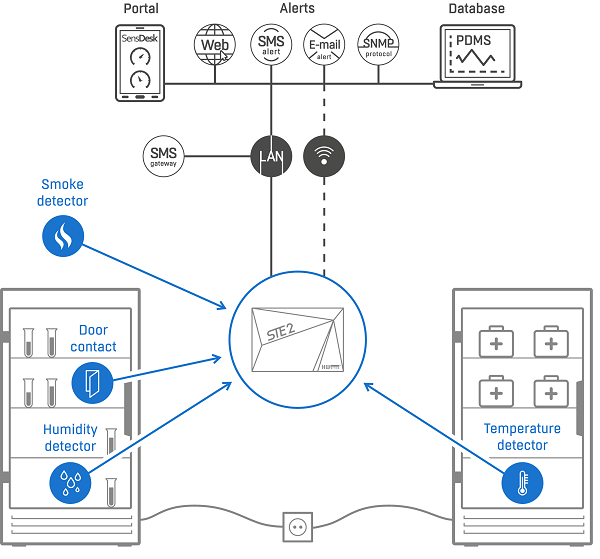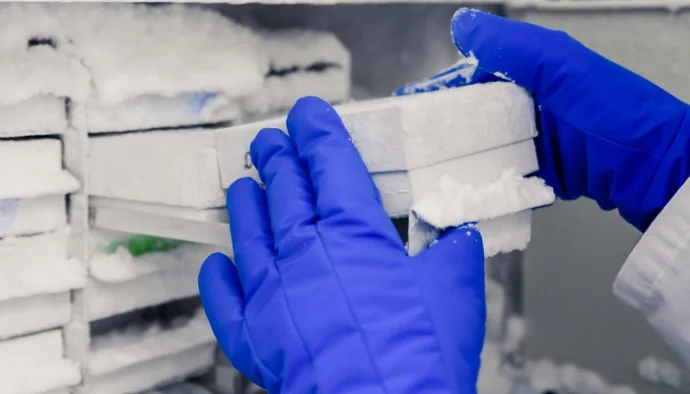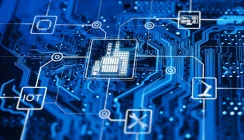Wireless Temperature Monitoring Systems for Hospitals, Medical Units and GP Surgeries
As the world comes to the realisation that a COVID-19 vaccine is on the way, everyone is becoming aware of the need to store these vaccines at specific temperatures. A recent article from the BBC reported on the need to use dry ice for one vaccine that requires storage at -70⁰C. Other vaccines may require higher storage temperatures but to be effective and have their expected shelf-lives, all require temperature controlled and monitored storage environments.
For several years some of our colleagues were involved in cold chain store programmes for medical organisations such as the World Health Organisation (WHO) and UNICEF. Principally the protection of fridges and freezers used to store vaccines in remote locations around the world. This experience, coupled with our extensive range of environment monitoring solutions means that we can provide a rapid response and easy to install temperature monitoring solutions to hospitals, medical facilities, doctors and mobile surgeries involved in the vaccine rollout programmes.
For more information on vaccine storage temperatures: https://www.bbc.co.uk/news/technology-54889084
Healthcare Fridges, Freezers and Facilities
The monitoring of temperature-sensitive assets in healthcare facilities such as hospitals and medical centres is a fundamental requirement to provide high-quality care to patients. Not just vaccines, but other medications, blood, and samples for testing in diagnostic laboratories need to be stored, tested, and used within set and tightly controlled temperature ranges. If temperatures rise higher than required there are medical and financial implications that can result in delayed treatment, vaccine roll outs and the time taken to replenish supplies. Humidity and pressure can also be important factors to monitor in hospital environments and must be constantly monitored and maintained.
Public Sector and Private Hospitals
It is no surprise that hospital and medical facilities are tightly regulated and must prescribed to specific standards and regulations. This means that they will have environmental monitoring systems in place. Some of the checks carried out may be manual, whereby staff check individual refrigerators, freezers and storage devices used to store temperature sensitive medicines and vaccines. Automated temperature monitoring systems like the STE2 R2 may also be installed.
Doctors GP Surgeries and Mobile Medical Units
The mass deployment of a COVID-19 vaccine is a huge logistical problem for the UK government. At a local level doctors’ surgeries and medical centres are going to see an unprecedented flow of people through their facilities. Mobile medical units, like screening lorries and trailers may also be deployed and buildings taken over temporarily for the vaccine programme. Let us not forget that any vaccine for COVID is not just a ‘magic bullet’. Annually boosters will be required, and this means that surgeries and medical practices will have to adjust to a new ‘norm’ with vaccine clinics becoming regular features.
Automated Wireless Temperature Monitoring
Rather than employ staff to check fridges and freezers, what is required is an automated and easy to deploy temperature monitoring solution. An environment monitor such as the STE2 R2 meets these requirements and can provide fully automated 24/7 monitoring for temperature, humidity, and a range of other environmental factors. A system like this is not just Wi-Fi enabled and can be monitored over a standard Ethernet LAN connection. SMS features can also be activated.
Fridge and Freezer Temperature Monitoring over Wi-Fi
The STE2 R2 is typically used in a computer room, server room or data centre to monitor the environment. The device can also be used in any organisational or business critical environment that requires remote monitoring on a 24/7 basis. Shelf or wall mounted the device is easy to install and can be powered from the AC power adaptor it is supplied with or by Power over Ethernet (PoE).
One 3m temperature sensor as standard, additional sensors can be plugged into the unit for humidity. Multiple sensors can be connected to the two sensor ports using the 1-Wire protocol.

With the STE2 R2 set ranges can be set including a safe range. As soon as the measured temperature or humidity moves outside the pre-set range, the device will send an email notification to a distribution list via the Sensdesk portal. Monitoring data and alerts can also be received locally over a local area network using SNMP or on-premises monitoring software.
As well as sensor ports, the STE2 R2 includes two digital inputs via a terminal. These provide added functionality including the ability to ‘pick-up’ inputs such as a door opening and send a relay signal to a third-party system, such as a building management system (BMS).
Multiple Point Temperature Monitoring on a Local Area Network
The STE2 is designed as a relatively low-cost monitoring solution that is easy to install in multiple locations. The product can communicate over Wi-Fi or a hardwired LAN IP/Ethernet connection via its RJ45 port.
For large medical facilities, a Poseidon2 4002 environment monitor can be used. Whilst this does not offer Wi-Fi connectivity, the Poseidon2 4002 can plug into a standard IP/Ethernet and offers up to 42 sensor connections and 12 digital inputs. Ideal where a larger number of systems need to be monitored. Smaller Poseidon2 devices include the 3266 and 3268.
GPRS Environment Monitoring
The Sensdesk monitoring portal can be used to send alarm alert emails. If one of these is to an Email-to-SMS service, users can be notified via mobile SMS text when there is an over or under temperature, high humidity or one of the many other environmental factors that can be monitored by an STE2 or Poseidon2 device.
For hospital and medical facilities wanted a hardware based GPRS mobile SIM-based monitoring system, the HWg-Ares12 unit is recommended. The Ares continuously monitors the environment via the sensor cables connected to it, whether for temperature or humidity or some other environmental condition. As soon as the measured data moves outside a specified safe range, the Ares device can send a text message using an internal SIM card.
Ares12 is also a data logger than can store up to 250,000 records and make the data available via a LAN software package. Digital inputs allow the device to monitor for door access and the monitoring device can operate independently to local LAN availability. If the mains power supply fails, a built-in battery provides local backup, allowing the Ares12 to send a power failure notice and continue to monitor its environment.
UPS Battery Temperature Monitoring
With multiple temperature connection points, environment monitoring devices like those described above can also be used to monitor other critical systems within a building. One of these could be the battery packs used with local uninterruptible power supplies. Lead acid UPS batteries are prone to rapid ageing when used in hot environments. By hot we mean temperatures above 25⁰C. For each one degree rise above 30⁰C the design life (typically 5 or 10 years) of a lead acid battery will halve. Whilst lithium UPS batteries are more temperature tolerant, additional temperature monitoring is recommended for large Li-ion battery installations in addition to that provided by the local battery management system.
Summary
A vaccine solution to the COVID-19 pandemic is a superb outcome but the logistical rollout for its safe distribution requires thought right down to the places where the vaccines will be stored and provided. Local surgeries and medical facilities, and even hospitals and medical centres may require additional environmental and temperature monitoring systems that are easy to install, set-up and use. The environment monitoring solutions available from Server Room Environments are ideal for these types of usage and installation. Our projects team provides additional installation and setup services and can be on-hand 24/7 to assist in any local authority or privately funded rollout programme. Site surveys both physical and via virtual conference calls are also available to assist projects and speed up any necessary planning and approvals required.


























